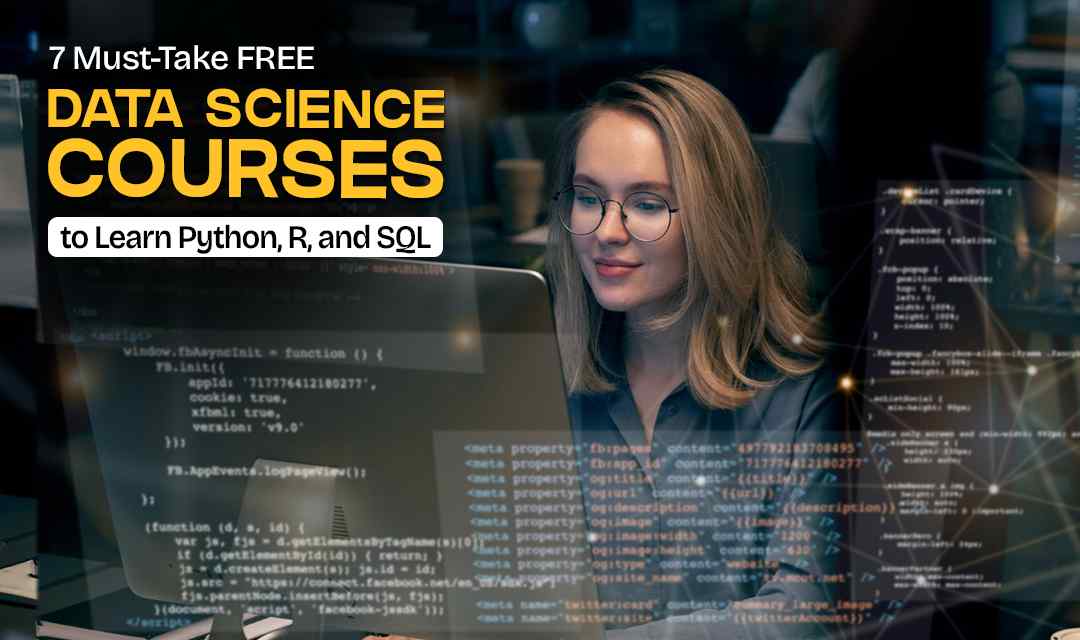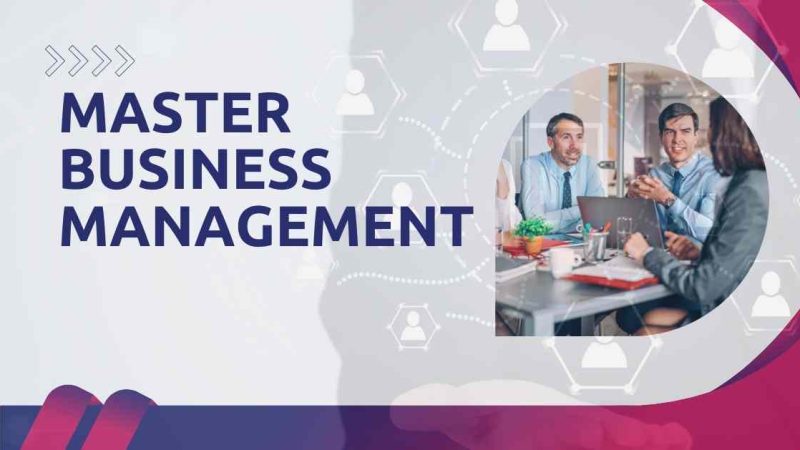7 Must-Take FREE Data Science Courses to Learn Python, R, and SQL

How can you learn a data science course for free? You can begin with these seven courses that teach Python, R, and SQL. Each of them gives you easy lessons and practice tasks so you can build real skills for real-world use.
A data science course shows how data shapes the world around us. Every click, search, or purchase creates information that businesses, governments, and researchers use to make decisions and solve problems. This is why data science ranks among the most important skills in the modern era.
Data science is a combination of programming, statistics, and analysis aimed at discovering trends. Python, R and SQL are leading here. Python for machine learning, R for statistics and SQL for databases. In this article, inspired by expert human dissertation helpers at The Academic Papers UK, we explain why data science matters, how data science courses can help and how to learn these skills step by step.
Top Lessons of the Article:
Here is what you need to know
- The most important data science languages for beginners are Python, R, and SQL.
- Free courses provide structured learning without financial barriers.
- Python courses focus on the basics, libraries like Pandas and NumPy
- R courses train learners to analyse and visualise statistics using the ggplot2 package.
- The practicality of skills and confidence is increased through hands-on projects in these courses.
- By completing these free courses, there is a great basis to study further data science.
Why Learning Data Science is Important?
The job market in data science is expanding annually. Every company requires individuals who can analyse and work with data in their industry. BLS reports indicate that the demand for data scientists is projected to grow 36 per cent from 2023 to 2033. It is also marked by salaries (In May 2024, data scientists earned a median annual salary of $112,590).
Salaries also highlight the growth rate of the data science courses. The demand is not limited to one region but spans Europe, Asia, and the Middle East. Learning data science opens many career paths, such as data analyst, machine learning engineer, research scientist, and business intelligence expert.
Practical applications
These uses show that data science has practical and lasting value. The influence of data science is vast and applies to numerous industries.
- In business, firms use it to study customer behaviour, to improve supply chains and to determine prices.
- In the healthcare industry, it can help physicians identify illnesses early and develop treatment plans.
- In finance, it aids in fraud detection, financial risk management, and investment planning.
- In studies, it reveals dissimilarities in climatology, genetics and societal fields. These applications indicate that a data science course is useful and sustainable.
Key Tools for Learning Data Science
Tools play an important role in learning data science. Some basic key tools for learning data science are mentioned below.
- Python is popular due to its easy syntax and good libraries, including Pandas and NumPy.
- R is popular in research work in statistics and graphical display.
- SQL is essential for managing and retrieving data from databases.
Collectively, these tools will result in a comprehensive set of skills for learners and professionals in data science.
Students of data science usually work on a dissertation or a thesis. These projects involve research, coding, and data analysis. Many students find it hard to organise their tasks, analyse results, or write in proper academic style. In such cases, turning to professional dissertation writing services without ChatGPT can be a better option. Experts provide well-researched data and also help to learn how to write a perfect data science dissertation.
How Free Courses Can Jumpstart Your Learning?
You don’t need to spend money to start learning data science. Many free data science courses are available online, making it easy for beginners to get started. Here are some of the key benefits of choosing free courses:
Know About: Maximizing your career potential with a data science course.
- Cost-effective: No financial stress. You study without excessive charges
- Flexible: Study the way you want. It is possible to work on data science courses during weekends, after work or at any other time.
- Accessible by anyone: Regardless of remote location, anyone with internet access has access to resources.
Free courses eliminate obstacles and help beginners enter the field of data science.
Platforms Offering High-Quality Courses
Several platforms provide excellent free data science courses:
- Coursera: Offers courses for beginners to advanced learners from top universities. Many are free to audit.
- edX: Offers a free course from an institute such as Harvard and MIT.
- Udemy: Providesfree online courses and paid courses too.
- Khan Academy: Easy lesson on statistics and SQL for absolute beginners.
- Kaggle and Google AI: Practice free Tutorials and Datasets.
Tips to Maximise Learning from Free Courses
By following these tips, learners make the most of free resources.
- Start with a study plan
- Make notes when you’re studying
- Attend online communities
- Revisit challenging topics often
Top 7 Free Data Science Courses
Data science has been revolutionising very fast. Many students often struggle to purchase expensive data science courses. In this situation, many students are looking for free data courses. Some of the top 7 free data science courses offered by Harvard University are mentioned below.
1: Python for Data Science
Python for Data Science is an introduction to Python that will give students a glimpse of the fundamentals of Python. You begin with the Python basics like syntax, variables and looping. The Python course then proceeds to data structures such as lists, dictionaries and sets, which are the core of data handling. It also uses important libraries, such as Pandas and NumPy, that help you analyse the data faster.
Pandas will help you with organising and working with data, and NumPy is used to perform numerical operations as efficiently as possible. Coursera stated that the data science course also provides practical sessions to implement concepts in real projects. Here, you learn the process of sorting, cleaning, and data analysis.
After, you will know about writing Python code for data tasks. This short-term data science course is perfect for beginners who have no programming experience. It lays down a good foundation so you can get to more complex machine learning, visualisation or big data. It helps you take the first step toward a career in data science.
2: R Programming for Data Analysis
Free R Programming Data Analysis courses help you learn the basics of R. You start by understanding the R syntax that helps you in writing clear code. The course focuses on teaching you how to work with data step by step. You jump into statistical analysis, which allows you to test data, identify trends, and draw conclusions.
This course enables handling visualisation data using ggplot2. It can help one generate graphs and charts easily to showcase the information. You work on real-life examples, which can help you with your research. A study published on Research Gate highlighted that R offers flexibility and precision for complex data problems.
By the end of the data science course, you will be familiar with using R to manage the data and generate useful insights. It is encouraged for those learners who would like to specialise in research or academic work. The course establishes your confidence level and readies you to study more data analysis and statistical modelling.
3: SQL for Data Science
The course SQL Data Science is a practical step in the basics of working with databases. You start by learning how to write queries, which will enable you to retrieve specific information in datasets. The SQL data science course helps you learn to use joins, which combine data found in separate tables, making it easier to analyse the connections.
You also practice aggregations, you use real-life data, which simplifies large amounts of information into clear insights. SQL is a fundamental skill for anyone in data science because it enables you to process and extract information quickly.
The Code Institute Studies indicate that SQL is one of the most desired skills of data professionals across the globe. At the end of the course, you will be confident in using SQL to organise, filter, and screen data. It can be used by beginners wishing to gain a basic foundation in the advanced studies of data science.
4: Data Visualisation with Python
Data Visualisation with Python is a course which allows you to create understandable and meaningful images out of raw data. Then you start with Matplotlib, which is a package that you can use to make basic figures like line graphs and bar plots. The data science course then introduces Seaborn, which enables you to create good-looking and informative visualisations.
You are also learning how to make interactive charts that make it easier to discover data. The contents of each lesson are aimed at practical skills, and so you gain hands-on experience with real examples.
The data science course emphasises the power of visual narrative. It displays how charts and graphs can be used to explain the trends and patterns that raw numbers cannot. According to the study of Syracuse University, people understand visuals 60,000 times faster than text, which makes data visualisation a critical skill for analysts and researchers.
By the end of the data visualisation course, you will understand the process of using Python tools to present data clearly and powerfully. This data science course is best suited to learners who need to transmit knowledge through visuals during research, business or academic work.
5: Machine Learning Basics with Python
Machine Learning with Python is a course that covers the main concepts of artificial intelligence. You begin by learning the distinction between unsupervised and supervised learning. The course explains how supervised learning uses labelled data to train models. The unsupervised learning finds hidden patterns without labels.
You also learn regression, which forecasts numerical values, and classification, which categorises the data. Every idea is explained in a step-wise manner, so you can understand how machine learning works in practice.
The data science course provides you with interesting projects with real-life datasets in which you learn to implement these methods. You have been practising the construction of models, verification of the accuracy, and refinement of results. ResearchGate stated that Python is the most popularly used language in machine learning owing to its influential libraries, such as scikit-learn and TensorFlow.
At the end of it, you will be ready to deploy the nuts and bolts of machine learning in solving problems. This course is perfect for beginners who want practical exposure and a solid foundation in AI.
6: Statistics for Data Science
Statistics for Data Science is a course that gives you the knowledge to understand and analyse data. You start with learning probability, which allows you to measure the chance of events and predict their outcome. The course then teaches descriptive statistics, where you learn to summarise the data in the form of mean, median and standard deviation.
You also discuss hypothesis testing, which enables verification of assumptions and drawing of conclusions based on data samples. Every idea is described using simple examples of how statistics work in practical circumstances.
According to Western Governors University, statistics are the backbone of data science because they guide accurate and data-informed decisions. Statistical techniques have been developed to help businesses, researchers, and policymakers determine trends and reduce uncertainty.
The data science course contains practice exercises to enable you to become confident in applying these tools. At the completion, you will know how to apply the statistics in analysing data and making better decisions. Such a course is highly advised for those learners who wish to engage in data science careers.
7: Applied Data Science Capstone Projects
Applied Data Science Capstone Projects is a course that helps you put your skills into practice. You work with real-world datasets, which give you the chance to apply what you learned in earlier courses. The data science course guides you through solving practical problems using data cleaning, analysis, and visualisation.
Another practice that you employ is the construction of predictive models and their application to actual situations. Every project allows you to build your skills as a data scientist and handle challenges step by step. The primary aim is to design portfolios you can present as a demo to employers. 21k school Studies reveal that employers place more importance on practical rather than theory-based experiences.
You get confidence after completing capstone projects because you know that your technical skills have increased. After the course, you should have a portfolio of projects showing your capacity to address data-driven challenges. That is why an applied data science course is important in establishing a career in data science.
Tips to Learn Python, R, and SQL Faster
Here are some practical tips which help you learn Python, R, and SQL Faster.
- Practice Daily: Practice daily (or at least half an hour each day).
- Practice Online challenges: Opportunities exist on sites such as Kaggle, LeetCode and HackerRank.
- Use Online Forums: Reddit, Stack Overflow, and GitHub are good online communities that offer support.
- Create Mini-Projects: Developers’ mini-projects with small apps, dashboards or analysis reports.
- Track Progress: Keep a track of your progress in what you learn daily.
How Professional Dissertation Support Can Help Data Science Students
A data science dissertation is more than just a project. It’s a chance to explore real-world problems using data. Many students get stuck not because they lack skills, but because managing research, coding, and data analysis all at once can be tricky. Professional help from ethical dissertation writing companies, for example, Affordable Dissertation UK and Cheap Essay Writing UK, doesn’t just complete tasks for you; it guides you to understand your work better and make smarter decisions.
How Experts Can Help?
- Planning and Structuring: Get advice on clear objectives and the best research methods.
- Data Analysis Support: Learn how to handle data effectively using Python, R, or SQL.
- Coding Guidance: Understand your scripts while fixing errors.
- Editing and Proofreading: Make your writing clear, accurate, and professional.
Why Does It Matter?
- Saves time so you can focus on learning.
- Improves the quality of your research and results.
- Builds skills and confidence for future projects.
Professional guidance is about learning smarter, not working less. It turns challenges into opportunities to grow as a data scientist.
Final Thoughts
One of the best assets of the day is data science courses. It provides growth, practical value, and self-fulfilment. The underlying tools of this domain are Python, R, and SQL. Free courses make it possible for everyone to learn. With hard work, persistence, and clever tactics, students can learn these abilities.
Now is the best time to start learning. Everything can be found in courses, practice platforms, and online communities, which are free. With perseverance, a learner can reshape their abilities and gain profitable careers in data science.
FAQs
Which Data Science Course is Best for Beginners in 2025?
In 2025, the most suitable course to take as a beginner is Python for Data Science, offered by Coursera. It has an introduction to Python, data types, and libraries such as Pandas and NumPy.
The learners study real-life examples, but that makes it easy to understand how data science operates. The course is easy, entertaining, and will not require any previous study of coding. It provides a solid foundation to help the novice or beginner before moving on to more advanced topics.
Can I Get a Job After Completing a Short Data Science Course?
Yes, you can get a job after completing a short data science course, but it depends on your skills and the job role. Many employers value practical knowledge in Python, R, SQL, and data visualisation. A short course gives you a strong start, but you should build projects and a portfolio. Entry-level roles like data analyst or junior data scientist are often open to learners with short training.





